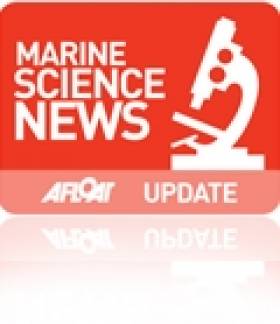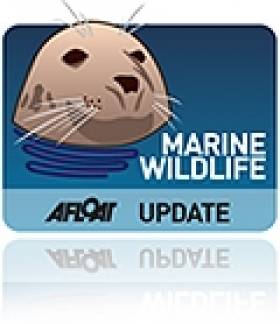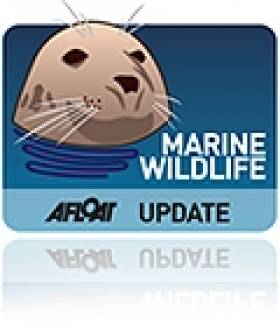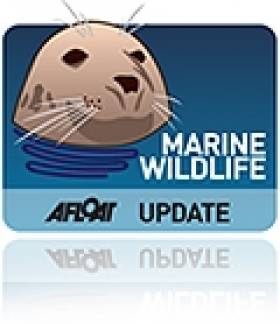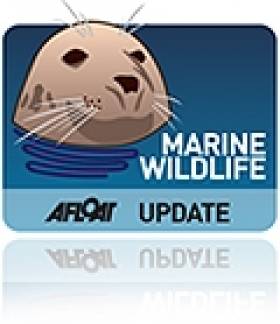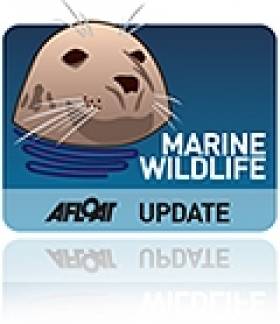Displaying items by tag: marine wildlife
Researchers Ask For Help In Global Plankton Survey
#MarineScience - Researchers at a UK university are hoping to enlist seafarers to help conduct one of the world's biggest studies of ocean plankton.
BBC News reports on the project by the Marine Institute at Plymouth University, which hopes to encourage fishermen and sailors alike to take part in its survey in Britain's coastal waters - including the Irish Sea - and far beyond.
Anyone participating in the study must drop off the side of their vessel an apparatus called a Secchi disk - a 30cm-wide flat white disk attached to a tape measure or a rope, and weighted from below by a small 200g weight.
When the disk disappears from view, that level is known as the Secchi Depth, which measures the turbidity of the water, which in turn is influenced by the amount of the microscopic marine wildlife in the water column.
Seafarers are being asked to record the Secchi Depth and upload to researchers via a mobile app for iOS and Android devices in order to build a complete picture of plankton activity in the world's oceans.
"If we can just get a small percentage of the global population of sailors involved, we can generate a database that will help us understand how life in the oceans is changing," said project leader Dr Richard Kirby.
"It would help us learn much more about these important organisms at a crucial time when their habitat is altering due to climate change."
BBC News has more on the story HERE.
Video: Courting Humpback Whales Duel Off Baltimore
#MarineWildlife - Check out this wonderful video - via the Baltimore Photos Facebook page - of two male humpback whales fighting over a prospective female partner off West Cork late last year.
Richard O'Flynn, who posted the footage to YouTube, says: "We were following two humpbacks for about 30 minutes when a third one turned up.
"What you're seeing here is the female to the right of the shot and her partner between her and the third humpback trying to keep him away from her. It went on for about one-and-a-half hours!"
O'Flynn said it was only his second time using the video camera "so please forgive the shake... and I was driving the boat at the same time!"
Recent Dolphin, Whale Strandings 'Very Unusual' Says IWDG
#MarineWildlife - The Irish Whale and Dolphin Group (IWDG) has described as "very unusual" a mass stranding of common dolphins on Achill Island last week - which was followed this week by the remains of cetaceans washed up in Kerry.
At least eight common dolphins were found dead on Keel Beach, Keem Beach and Dookinella on the Co Mayo island at the end of January.
And The Irish Times reports that two pilot whales and an "otherwise healthy" dolphin were found washed up at Cuas Croom near Cahirciveen in the last few days.
Commenting on the former incident, IWDG stranding officer Mick O'Connell said: "While there are occasionally live strandings involving groups of dolphins, it is very unusual in this country to see this number of dead dolphins washed ashore over a 10km area."
Strandings of deceased dolphins have also been reported in Donegal, and the IWDG's Simon Berrow suggests that the recent severe weather experienced around Ireland's coast may be a factor.
White-Tailed Sea Eagles Found Dead in Southwest
#MarineWildlife - RTÉ News reports on the discovery of two dead white-tailed sea eagles in Kerry and West Cork.
The bird found washed up near Glengariff in West Cork two weeks ago was confirmed as poisoned after a post-mortem at the State Laboratory in Celbridge.
According to its electronic tag, the female sea eagle was released in Kerry more than two years ago.
Meanwhile a second bird found in south Kerry earlier this week is also believed to have been died as a result of eating poisoned carrion - an illegal method sometimes employed to control crows and foxes preying on lambs.
A protected species under Irish law, some 100 while-tailed sea eagles were reintroduced to the wild in Killarney National Park from 2007 to 2011. Since that time more than a quarter have been found dead, with 12 of those cases confirmed as poisonings.
'Frontier' Surveyors Meet Sperm Whales and Killer Whale
#MarineWildlife - Sperm whales and a killer whale were among the finds on the last big effort of this year's Cetaceans on the Frontier survey led jointly by the Galway-Mayo Institute of Technology (GMIT) and the Irish Whale and Dolphin Group (IWDG).
As previously reported on Afloat.ie, marine scientists from GMIT's Marine and Freshwater Research Centre are on board the RV Celtic Explorer to carry out the fourth dedicated survey of cetaceans on the continental shelf edge.
The ship was surveying a zig-zag pattern in the Atlantic yesterday 2 February, some 55 nautical miles west-by-northwest of Achill Island (visible on this map HERE) when the team encountered at least two sperm whales, though an elusive third may also have been present - as indicated by the hydrophone being towed 200m behind the vessel.
"The blows continued and as we got closer, more and more body of the surfacing whale could be seen until we were treated to some reasonable views of the steep nose, long flat back and stumpy dorsal fin on initial surfacing followed by a thick tail stock with ‘knuckles’ seen when flaking," writes Niall Keogh on the Cetaceans on the Frontier blog.
Soon after that, the researchers were treated to their first sight of a killer whale in Irish waters - followed by a number of pilot whales surfacing close to the ship.
More Dead Seals Wash Up On Wexford Beach
#MarineWildlife - The Gorey Guardian reports that three seal carcasses were found washed up on Duncannon beach in Co Wexford this past Tuesday (22 January).
The National Parks and Wildlife Service is presently awaiting lab results to determine the seals' cause of death, a situation conservation ranger Tony Murray describes as "quite unusual".
He added that the carcasses of the three marine mammals were freshly dead and found to have no external injuries
As previously reported on Afloat.ie, the Irish Seal Sanctuary last month called for immediate action after a total of 12 seal carcasses were found dead on beaches in Wexford and Waterford in the span of a single week.
Tangled Dolphin Seeks Help From Divers
#MarineWildlife - The Irish Examiner reports on the extraordinary story of a bottlenose dolphin who turned to a group of divers for help to free it from a fishing line.
The video above captures the touching scene when the cetacean approached the divers as they filmed a group of manta rays in the Pacific waters near Kona in Hawaii.
As the footage shows, the dolphin positioned itself in such as way as to allow diver Keller Laros to cut the fishing tackle that was tangled tightly around its midsection and remove the hook from its left pectoral fin.
After the dolphin took to the surface for a quick breather, the divers were able to free it from the line and allow it to swim away unharmed.
Man Saves Children from Shark Attack
#MarineWildlife - The video below from the Guardian captures the moment when a brave Welsh tourist wrestled a shark away from a beach crowded with children in Australia.
As BBC News reports, 62-year-old Paul Marshallsea took charge of the situation by grabbing the two-metre-long dusky shark by the tail and dragging it away from the shallows at the beach on Queensland's Sunshine Coast - narrowly missing being bitten in the process.
"My instincts took over and I just grabbed the shark by the tail," said Marshallsea, who added that the ocean predator "nearly took my leg off in a split second - it was that quick."
Though few attacks by dusky sharks have been recorded, the species is regarded as "potentially dangerous" to humans due to their large size.
First Whales Of The Year Caught On Video
#MarineWildlife - Here's a little something cheerful to brighten up this chilly, snowy Monday morning: some video footage from YouTube shot by Irish Whale and Dolphin Group (IWDG) member Karl Grabe of the first whales to visit Ireland's shores in 2013.
As previously reported on Afloat.ie, the first sightings were made last week on the maiden member whale-watching trip on board the IWDG's new marine wildlife research vessel Celtic Mist off the coast of Wexford.
In addition to these fin whales, the group also made the acquaintance of a group of frolicking dolphins from the 'superpod' spotted in the Irish Sea recently, as you can see from the clip below:
Wexford Whale-Watching Trips As Seen On TV
#WexfordWhales – Further exciting scenes of cetaceans where witnessed by those on board Celtic Mist yesterday, following the first such sightings in 2013 as previously reported on Afloat.ie
Footage of the action was broadcast on this evening's RTE Six One news, from the decks of Ireland's newest marine research vessel, operated by the Irish Whale & Dolphin Group (IWDG).
This month, Celtic Mist will be making day trips in search of whales from Ballyhack on the Wexford side of the Waterford Estuary. In addition the 56ft ketch is to provide daily trips throughout February, when she will be based out of Kilmore Quay to where she heads for the waters off the Saltee Islands, weather permitting.
If you would like to join Celtic Mist for a day out, email: [email protected] or call 086 2358771 to make a booking and for further details visit www.rvcelticmist.ie
Celtic Mist, retains her original name from her days during ownership of the Haughey family, until she was donated to the IWDG back in 2011. She was refitted for her new role and she made her maiden voyage last September.
She was completed in 1974 by Custo in Brittany, France and designed by Dominique Presles. A 350HP diesel Caterpillar engine provides a maximum speed of 8.5 knots and a cruising speed of 6 knots. Facilities include a large galley, chart/navigation area and accommodation for eight berths.


























